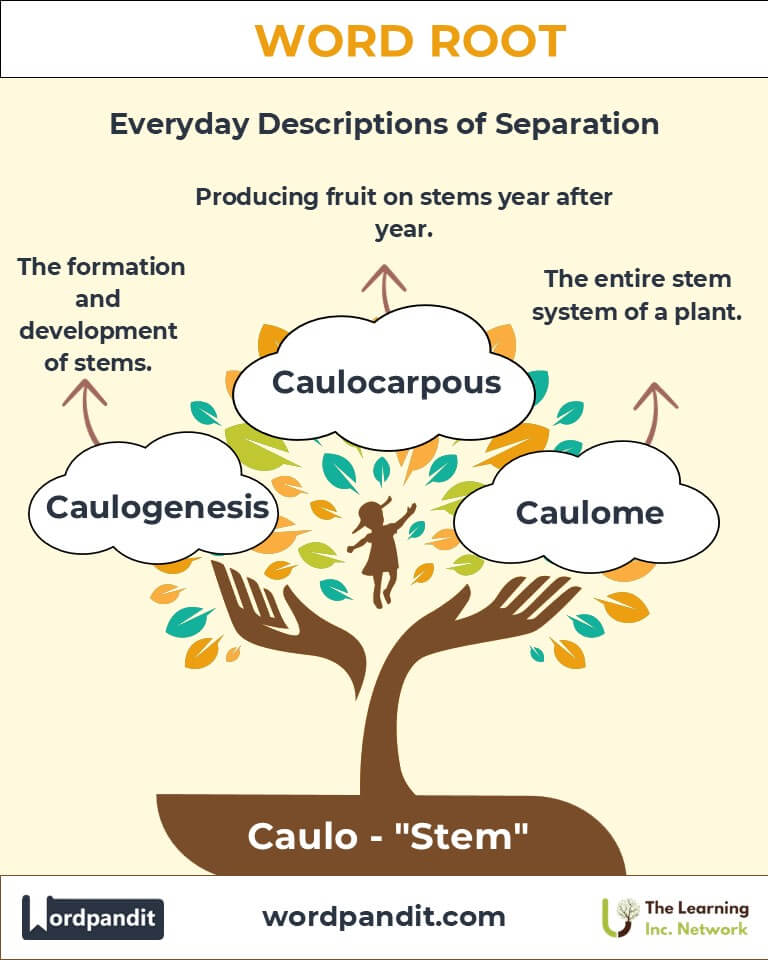Caulo: The Root of Growth in Stems and Structures
Dive into the linguistic and biological significance of the root "Caulo," originating from the Greek word for "stem." From botanical terms like "cauline" to unique morphological descriptions such as "cauliform," this root highlights the foundational role of stems in life and language.

Table of Contents
- Introduction: The Significance of "Caulo"
- Etymology and Historical Journey
- Mnemonic: Unlocking the Power of Caulo
- Common "Caulo"-Related Terms
- "Caulo" Through Time
- "Caulo" in Specialized Fields
- Illustrative Story: "Caulo" in Action
- Cultural Significance of the "Caulo" Root
- The "Caulo" Family Tree
- FAQs About the "Caulo" Word Root
- Test Your Knowledge: "Caulo" Mastery Quiz
- Conclusion: The Enduring Legacy of "Caulo"
1. Introduction: The Significance of "Caulo"
Imagine a plant's stem—the structure that supports life, transports nutrients, and symbolizes resilience. The root "Caulo" (pronounced kaw-loh) comes from the Greek word kaulos, meaning "stem." Its significance transcends botany, capturing the essence of growth, support, and formation in both literal and metaphorical contexts.

2. Etymology and Historical Journey
"Caulo" finds its roots in ancient Greek, where kaulos denoted the stem of a plant. Over centuries, this term entered the lexicon of biology and morphology, shaping scientific descriptions of plant structures and their derivatives. As botanical sciences advanced, "caulo" was integrated into terminology that described stem-based formations, emphasizing the functional and symbolic importance of stems in growth and connectivity.
3. Mnemonic: Unlocking the Power of Caulo
To remember "Caulo," visualize a strong plant stem holding up vibrant flowers.
4. Common "Caulo"-Related Terms
- Cauline (kaw-leen): Pertaining to or growing on a stem.
Example: "The leaves were cauline, growing directly from the plant's main stem." - Cauliform (kaw-luh-form): Resembling or having the shape of a stem.
Example: "The cauliform design of the sculpture mimicked the organic structure of plants." - Caulocarpous (kaw-lo-kar-puhs): Describes plants that produce fruit on stems year after year.
Example: "Certain trees are caulocarpous, bearing fruit on their perennial stems." - Caulicle (kaw-li-kl): A small stem or the embryonic axis of a plant.
Example: "The caulicle of the seedling was barely visible." - Caulome (kaw-lohm): The stem or axis of a plant body in its entirety.
Example: "The researcher focused on the development of the plant's caulome."
5. "Caulo" Through Time
- Caulicle: From ancient botanical studies, the term emphasized embryonic plant growth, showcasing early recognition of stem importance.
- Caulocarpous: Once used primarily in scientific classification, it now highlights the ecological roles of stem-bearing plants in modern studies.
6. "Caulo" in Specialized Fields
- Botany:
- Term: Cauline
- Application: Describes plants with leaves or flowers directly attached to stems, emphasizing structural adaptation.
- Morphology:
- Term: Cauliform
- Application: Used in structural biology to describe stem-like formations in various organisms.
- Ecology:
- Term: Caulocarpous
- Application: Highlights the ecological importance of stem-bearing plants that produce fruits over extended periods.
7. Illustrative Story: "Caulo" in Action
In a lush forest, a young botanist named Lina marveled at a towering tree known for its caulocarpous nature. Observing its cauline leaves and sturdy caulome, she realized the tree's role in supporting diverse wildlife. Inspired, she created an architectural model with cauliform structures, mimicking the tree’s efficiency and beauty. Her work bridged the gap between nature and innovation, showing how "Caulo" embodies growth and support in multiple dimensions.
8. Cultural Significance of the "Caulo" Root
Stems symbolize resilience and connectivity in various cultures. From ancient Greek myths celebrating plant life to modern ecological movements, the "Caulo" root reflects humanity's admiration for the structures that sustain life. In art and architecture, cauliform designs often appear as metaphors for strength and organic harmony.

9. The "Caulo" Family Tree
- Phyll (Greek: "leaf"):
- Phyllotaxis: The arrangement of leaves on a stem.
- Radic (Latin: "root"):
- Radical: Pertaining to the root of a plant or a fundamental change.
- Culm (Latin: "stalk"):
- Culmiferous: Bearing a stem or stalk.
10.FAQs About the Caulo Word Root
Q: What does "Caulo" mean?
A: "Caulo" means "stem," derived from the Greek word kaulos. This root is widely used in botany to describe structures related to stems, such as leaves, fruit-bearing stems, and the entire stem system of a plant.
Q: What are cauline leaves?
A: Cauline leaves grow directly from a plant's stem rather than at its base. This feature is crucial for identifying plant species and understanding their structural adaptations.
Q: What does "Cauliform" describe?
A: "Cauliform" refers to something resembling or shaped like a stem. This term can describe natural structures like certain fungi and plants or artistic and architectural designs inspired by stems.
Q: What are caulocarpous plants?
A: Caulocarpous plants are species that produce fruit on their stems year after year. These perennial fruit-bearing structures play vital roles in ecology and agriculture.
Q: How is "Caulo" used outside of botany?
A: "Caulo" extends beyond botany into morphology and design, describing columnar or stem-like forms. It inspires structural elements in architecture and art, symbolizing resilience and organic harmony.
11.Test Your Knowledge: Caulo Word Root Quiz
1. What does "Caulo" signify?
2. What does "Cauline" describe?
3. Which term refers to stem-like structures?
4. What does "Caulocarpous" mean?
5. What is the embryonic axis of a plant called?

12. Conclusion: The Enduring Legacy of "Caulo"
The root "Caulo" highlights the essential role of stems in growth and life. From its etymological roots in Greek to its applications in botany, morphology, and design, "Caulo" symbolizes strength, support, and connection. By exploring this root, we gain a deeper appreciation for the structures that hold life together, inspiring innovation and sustainability.











